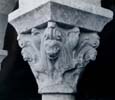Joining the pieces
Like Isis and Osiris, we would have to travel to at least three places to find the pieces of the monastery. I've seen half of it reconstructed at Cuixa, probably with money that came from selling the other half to the Metropolitan Museum in New York, where it has been reconstructed as part of the Cloisters. The central fountain and a few smaller pieces are at the Philadelphia Museum of Art. At Cuixa two sides of the square cloister are rebuilt, the el wide open to the sky and giving a very different impression than one gets from seeing the materials from two sides used to construct a four-sided enclosure (like the Cloisters) enclosing a courtyard one quarter the size. This was an important monastery.
Coming inland from the Mediterranean Sea, Canigo is the first peak of the Pyrennees that, at 2785 meters, is truly impressive, its peak covered in snow usually ten to twelve months of the year - it likely had symbolic importance from Megalithic times onward. San Miquel de Cuixa is two or three miles North of the peak, on the slope of what is now French Catalunya. It's more accessible for year-round travel, and at the same time still identified with Canigo. Sant Marti de Canigo is closer to the peak (and the inherent dangers from lightning strikes - at the peak itself various crosses commemorate people who were struck by lightning on the spot).
Hermetic hermits?
It is possibly just a linguistic coincidence that has led to confusing the two. In its origins the word hermit described a desert dweller, usually a recluse for religious aims, whereas the Hermetic tradition is a set of philosophical ideas developed by the followers of Hermes Trismegistus, aligning itself with the mythology of the Greek god Hermes (the same as the Roman god Mercury - the messenger of the gods, embodiment of wisdom, among other things). Alchemy has its origins in the Hermetic tradition.
I'll merely note that Hermes, Like Michael, was a denizen of the heights, and, in the upper regions many paths cross. Above Sant Esteve d'en Bas a Roman temple of Mercury has a truly commanding view over a large section of the lines I've described. Oliba's pursuit of wisdom from many traditions may be symbolized in his peculiar signature, so much like the alchemical symbols.


